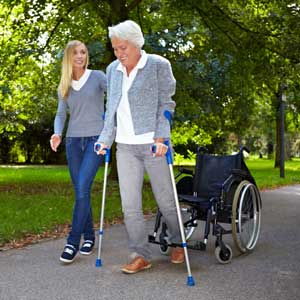 When considering health from a broad perspective,
people with chronic disabilities may be healthier or have greater well-being than someone without a chronic illness or condition. This interesting paradox also applies to quality of life. People with chronic disabilities often have
a higher quality of life score on questionnaires than one would expect. While those on the outside may focus on the losses and limitations that come with the disability, those living with the disability may focus on what they have
and what they can do. Despite their disability, those individuals are healthy in the broad sense of the word.
When considering health from a broad perspective,
people with chronic disabilities may be healthier or have greater well-being than someone without a chronic illness or condition. This interesting paradox also applies to quality of life. People with chronic disabilities often have
a higher quality of life score on questionnaires than one would expect. While those on the outside may focus on the losses and limitations that come with the disability, those living with the disability may focus on what they have
and what they can do. Despite their disability, those individuals are healthy in the broad sense of the word.
 Individuals with a chronic
disability need the same things as their caregivers in order to maintain physical health: good nutrition, sufficient sleep and some physical activity.
Individuals with a chronic
disability need the same things as their caregivers in order to maintain physical health: good nutrition, sufficient sleep and some physical activity.
Physical activities must be chosen with the person’s functional abilities and limitations in mind and with the recognition that these will change over time. People with chronic conditions sometimes find that their ability to carry out life tasks really doesn’t change much for a long period of time. Then they may notice a steady change in what they can do comfortably. Others experience some changes initially, and then remain stable for a time before more change is noticed. Change in functional abilities may first be noticed in these areas:
- Fatigue - weariness caused by exertion
- Strength – the power of your muscles to apply and maintain force; changes may be experienced when gripping, lifting, pulling, turning and other actions
- Coordination - control of muscles to accomplish a movement accurately, efficiently and repeatedly
- Tone and spasticity – failure of muscles to contract efficiently, or tendency of muscles to over-tighten and not relax easily on demand
- Mobility – ability to move around in one’s environment
- Sensory abilities – clarity of sight and hearing, sensitivity of touch, smell and taste
- Fragile medical status – tendency of the person’s medical status to deteriorate under stress or when exposed to bacteria or viruses
Activities that the person once enjoyed may become more challenging and less enjoyable. The value of basic life activities at home and at work may need to be re-examined and new ways to accomplish them may need to be found. While some physical activities can simply be done differently, other activities may need the addition of assistive tools or equipment. There are a variety of assistive devices and mobility aids available that allow individuals with chronic disabilities to carry out physical activities independently. More information on the impact of physical changes on life activities and effective strategies and assistive devices is found in Module F.
A chronic disability can also reduce stamina and the ability to perform intellectually-demanding tasks:
 Visual impairments can be disheartening to an avid
reader.However, many books are available on CD from bookstores and public libraries. The Internet is an excellent source of e-books and podcasts that can be downloaded free and played on computers, tablets,
smart phones and mp3 players.
Visual impairments can be disheartening to an avid
reader.However, many books are available on CD from bookstores and public libraries. The Internet is an excellent source of e-books and podcasts that can be downloaded free and played on computers, tablets,
smart phones and mp3 players.- Television shows and movies can be recorded, allowing the individual to pause a program if fatigued and repeat sections that have been forgotten or did not make sense the first time through. Captions and subtitles can add meaning when hearing is impaired. Some movies and television programs are also captioned for the visually impaired, adding details about what is being viewed.
- It is increasingly easy to find games and activities to build and maintain intellectual health at all levels of ability. Some have been specifically designed for individuals with limited mobility, memory impairment and/or few computer skills. Bridge and other card games, as well as chess and other board games, are available on the Internet and players can interact with each other while they play.
More information on dealing with specific intellectual limitations to maintain cognitive health is found in Module D.
Emotional health is particularly important and is likely to be affected by physical and cognitive limitations:
 Individuals may experience frustration when
they cannot accomplish life tasks as easily as they once did.They may grieve the loss of functions or become depressed about the slow rate of recovery. These feelings are natural, but also challenging, as they
may prevent individuals from doing as much as they can for themselves or being willing to accept help for their emotional issues.
Individuals may experience frustration when
they cannot accomplish life tasks as easily as they once did.They may grieve the loss of functions or become depressed about the slow rate of recovery. These feelings are natural, but also challenging, as they
may prevent individuals from doing as much as they can for themselves or being willing to accept help for their emotional issues.- On the other hand, improved health in other areas (e.g.,intellectual or social well-being) can have a positive effect on emotional health. Similarly, the relationship between physical activity and its ability to reduce stress and increase emotional well-being is well known.
It is difficult for caregivers to see their loved ones in emotional pain and not be able to fix it. In these situations, support and encouragement are important for both the caregiver and the loved one:
- Try to find experiences and activities that both of you find pleasurable and make them part of every day.
- Share jokes and funny stories.
- Focus on the positives and the joys that are available.
- Staying connected with friends, families and interests has benefits for both of you.
More information on dealing with emotional issues is found in Modules 3, B and C.
 Social connections are important to
maintain perspective,stay involved and remain a part of life. It is easy for individuals with chronic disabilities to become isolated. For example, hearing loss or communication challenges can keep people from
enjoying time with others and cause them to feel left out of the conversation. Interactions should be arranged to support the individual to be involved and feel a part of things. This may include playing simple
games together where the interaction is largely visual and nonverbal. Touch and gestures may be used instead of (or in addition to) words to convey meaning and emotion. More information on dealing
with communication challenges is found in Module A.
Social connections are important to
maintain perspective,stay involved and remain a part of life. It is easy for individuals with chronic disabilities to become isolated. For example, hearing loss or communication challenges can keep people from
enjoying time with others and cause them to feel left out of the conversation. Interactions should be arranged to support the individual to be involved and feel a part of things. This may include playing simple
games together where the interaction is largely visual and nonverbal. Touch and gestures may be used instead of (or in addition to) words to convey meaning and emotion. More information on dealing
with communication challenges is found in Module A.
An important social connection for many individuals with chronic disabilities involves intimacy and sexual expression. For the caregiver who is providing support to a spouse or life partner, changes in sexual activity due to the chronic disability can affect both parties’ social,emotional and physical health. More information on dealing with intimacy and sexuality issues is found in Module E.
 Spiritual health of individuals
with chronic disabilities may be affected in several ways:
Spiritual health of individuals
with chronic disabilities may be affected in several ways:
- Transportation issues, fatigue or other disability-related factors may prevent individuals from attending and participating in religious observances as often as they would like.
- Reduced involvement may cause them to no longer feel part of the religious or spiritual community.
- The disability and its impact may also lead individuals to question their spiritual beliefs and values. They may lose faith and wonder,“Why me?”
On the other hand, the impact of chronic disabilities may also strengthen the depth of people’s spiritual beliefs. To the extent that the individual is part of a spiritual community, caregivers can draw on leaders and other members of that community to become involved and provide support for continued participation. Requests to ministers, priests, rabbis and imams for home visits for members of their religious community can help to maintain spiritual connections and promote spiritual health.